L. vannamei shrimp showed better grow-out performance and zootechnical indices than F. brasiliensis under biofloc technology culture conditions
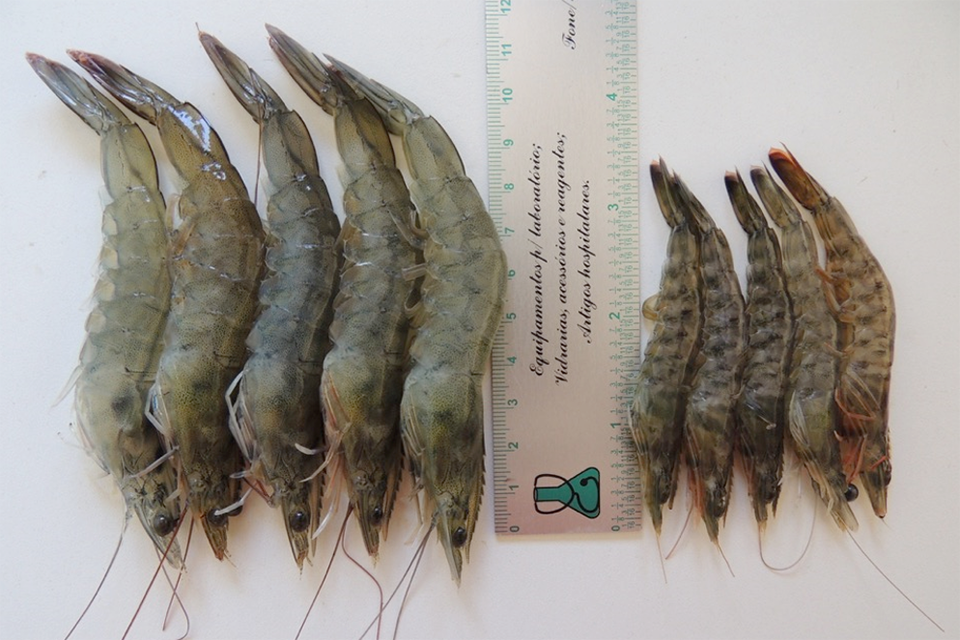
The significant production growth for farmed crustaceans – around 11 million tons, or 9.2 percent of total aquaculture production – reported by the Food and Agriculture Organization of the United Nations is mainly due to the excellent zootechnical indices, high production rates, lower protein requirements, and the significant market acceptance of the Pacific white shrimp (Litopenaeus vannamei), which accounts for 52 percent of production by all farmed crustaceans.
Despite their higher nutritional requirements, shrimp species native to Brazil can be of interest to the aquaculture industry. For example, the pink shrimp (Farfantepenaeus brasiliensis) has been shown by researchers to have the potential to grow in confined environments. The species ranges from North Carolina (USA) to the coast of Rio Grande do Sul (Brazil) and is one of the primary fishing resources of the southeastern Brazilian coast.
However, one of the main limitations to its production is the lack of a specific commercial feed that meets its nutritional requirements, as it is the lack of a complete technological package that would guarantee the economic viability of production, challenging the economic viability of its production.
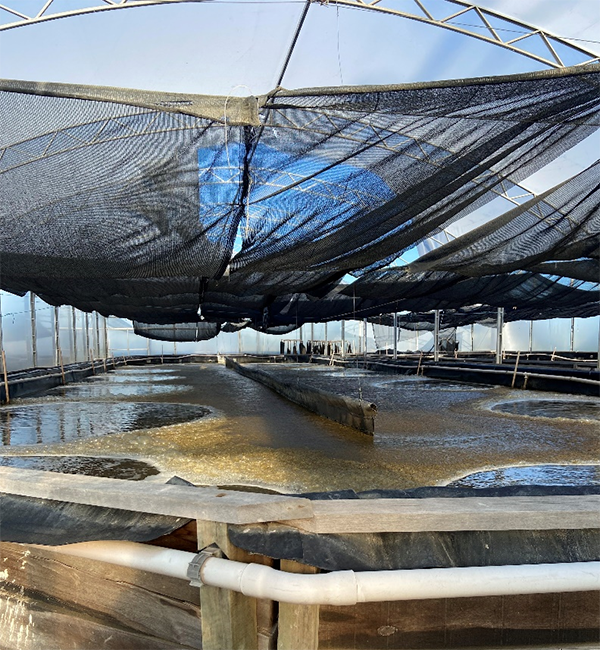
The Pacific white shrimp has been one of the main species used for studies in biofloc technology (BFT) systems and enjoys an already developed and consolidated technological package for commercial production. Various studies have reported that bioflocs are important food sources for this species for reproduction and the post-larvae stage, and that the contribution of this food source can vary from 63 to 86 percent in the grow-out phase.
But few studies have evaluated the zootechnical performance of other, native species like F. brasiliensis in a BFT system. Some studies have shown its potential but only focused on the nursery phase, with further research needed to assess the potential and economic viability of F. brasiliensis and other native shrimps in biofloc system, especially in the grow-out phase.
This article – summarized from the original publication (Krummenauer, D. et al. 2024. Comparative Analysis of the Culture of Pink Shrimp Farfantepenaeus brasiliensis and Pacific White Shrimp Litopenaeus vannamei in Biofloc System. Aquac. J. 2024, 4(1), 1-14) – reports on the results of a study to evaluate the potential of rearing pink shrimp F. brasiliensis in a BFT system during the grow-out to market size phase.
Study setup
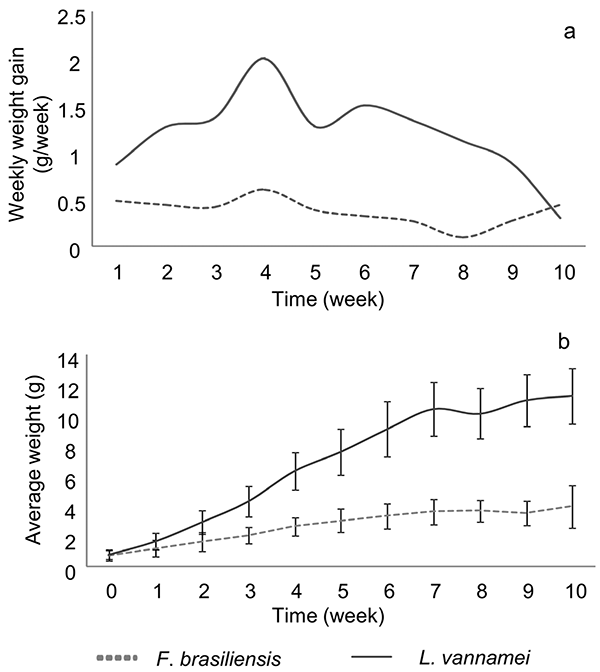
The study lasted 70 days and was conducted at the Marine Station of Aquaculture at the Federal University of Rio Grande, Rio Grande do Sul State, Brazil. The experiment comprised two treatments that compared the cultures of the two shrimp species in a biofloc system: (FB), grow-out of F. brasiliensis; and (LV), grow-out of L. vannamei.
The animals were stocked with initial weights of 0.72 ± 0.37 grams (F. brasiliensis) and 0.78 ± 0.29 grams (L. vannamei) at a stocking density of 100 shrimp per square meter for both species. The shrimp were fed twice daily using a commercial diet (Potimar GUABI™) with 38 percent crude protein. Throughout the experiment, water quality parameters (temperature, pH, dissolved oxygen, and total suspended solids), nitrogen and phosphate compounds (ammonia, nitrite, nitrate, and orthophosphate) and zootechnical performance parameters (final weight, productivity, survival, and feed conversion rate). The third maxillipeds (anterior thoracic limbs modified to function as mouth parts) of individuals from both species were collected and processed, and samples subjected to scanning electron microscopy (SEM) analysis.
For detailed information on the experimental design, animal husbandry, and data collection and analyses, refer to the original publication.
Results and discussion
The water quality results showed no significant differences between the treatments and are shown in Table 1. The water quality results are within the appropriate parameters for both species.
Krummenauer, Biofloc, Table 1
| Parameters | F. brasiliensis | L. vannamei |
|---|
Parameters | F. brasiliensis | L. vannamei |
|---|---|---|
| Temperature (degrees-C) | 25.4 ± 3.1 | 25.7 ± 3.2 |
| Dissolved oxygen (mg L−1) | 6.6 ± 0.5 | 6.5 ± 0.4 |
| pH | 8.1 ± 0.2 | 8.0 ± 0.2 |
| Salinity | 32.8 ± 0.7 | 33.12 ± 0.8 |
| Alkalinity (mg of CaCO3 L−1) | 157.7 ± 23.3 | 143.56 ± 22.1 |
| Total suspended solids (mg L−1) | 298.5 ± 119.7 | 299.7 ± 128.4 |
| Turbidity (NTU) | 105.0 ± 83.9 | 110.8 ± 90.2 |
| TA- N (mg L−1) | 0.15 ± 0.11 | 0.20 ± 0.18 |
| NO2- N (mg L−1) | 0.3 ± 0.2 | 1.1 ± 1.30 |
| NO3- N (mg L−1) | 17.9 ± 8.8 | 19.1 ± 9.6 |
| PO34- P (mg L−1) | 1.43 ± 0.93 | 1.30 ± 1.0 |
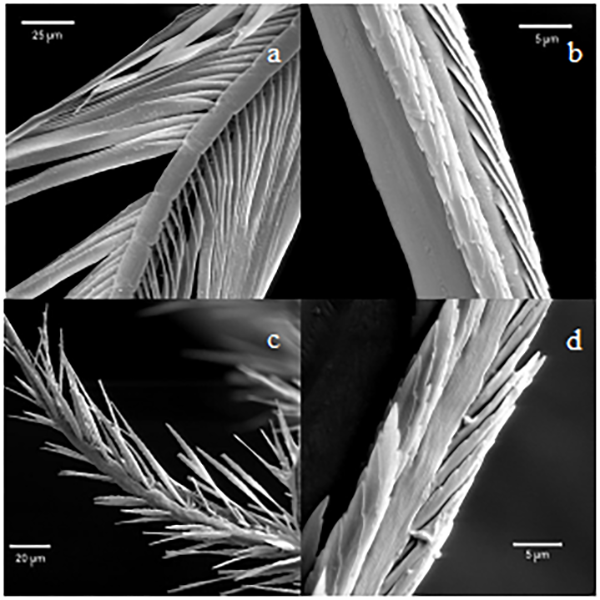
The weekly growth rate (Fig. 2a) was also higher (p < 0.05) for L. vannamei. Similarly, the final weight of L. vannamei shrimp (11.28 ± 1.89 grams) was significantly higher (p < 0.05) compared to F. brasiliensis (3.96 ± 1.40 grams) (Fig. 2b). Survival percent was 64.50 ± 9.68 for F. brasiliensis and 98.12 ± 6.12 for L. vannamei. Productivity (Kg per square meter) was higher for the treatment with L. vannamei (1.12 ± 0.01) compared to the treatment with F. brasiliensis (0.26 ± 0.05). The results of the zootechnical performance of the two treatments were statistically different (p < 0.05).
Scanning microscope photographs of the structure of the third maxilliped show that the parts (endopods) of the third maxilliped of L. vannamei are covered with longer, more abundant, and feathery bristles (Fig. 3 a, b), which make it easier to capture biofloc particles. In contrast, F. brasiliensis (Fig. 3 c, d) has straighter and shorter bristles, making it more challenging to capture floc particles.
The water quality parameters were within the expected range for both species, showing that this factor did not influence the zootechnical performance of the cultured animals. The results of the zootechnical performance of F. brasiliensis may indicate the species’ lack of adaptability to efficiently consuming biofloc. Another essential factor to highlight is that the commercial feed used in this study is produced according to the nutritional requirements of L. vannamei, and there is no commercial feed available formulated for native species such as F. brasiliensis.
Based on the results obtained in the present study, the pink shrimp (F. brasiliensis) has lower zootechnical indices compared to the Pacific white shrimp (L. vannamei), showing that the former species still needs further research and testing to be successfully adapted to the BFT system during the grow-out phase.
Significant advances are still required for the successful culture of various native shrimp species, including new studies on their nutritional needs, protein digestibility, stocking densities, genetic improvement and consumption, and their use of bioflocs.
Now that you've reached the end of the article ...
… please consider supporting GSA’s mission to advance responsible seafood practices through education, advocacy and third-party assurances. The Advocate aims to document the evolution of responsible seafood practices and share the expansive knowledge of our vast network of contributors.
By becoming a Global Seafood Alliance member, you’re ensuring that all of the pre-competitive work we do through member benefits, resources and events can continue. Individual membership costs just $50 a year.
Not a GSA member? Join us.
Authors
-
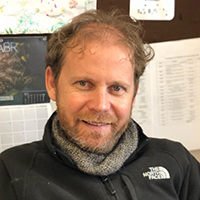
Dariano Krummenauer, Ph.D.
Corresponding author
Laboratory of Ecology of Microorganisms Applied to Aquaculture, Institute of Oceanography, Federal University of Rio Grande, Rio Grande, RS, Brazil -
André Freitas da Silva, M.Sc.
Shrimp Culture Laboratory, Institute of Oceanography, Federal University of Rio Grande - FURG, Rio Grande, RS, Brazil
-
Missileny Xavier, M.Sc.
Laboratory of Ecology of Microorganisms Applied to Aquaculture, Institute of Oceanography, Federal University of Rio Grande, Rio Grande, RS, Brazil
-
Geraldo Kipper Foes, Ph.D.
Shrimp Culture Laboratory, Institute of Oceanography, Federal University of Rio Grande - FURG, Rio Grande, RS, Brazil
-
Luís H. Poersch, Ph.D.
Shrimp Culture Laboratory, Institute of Oceanography, Federal University of Rio Grande - FURG, Rio Grande, RS, Brazil
-
Alessandro Cardozo, Ph.D.
Shrimp Culture Laboratory, Institute of Oceanography, Federal University of Rio Grande - FURG, Rio Grande, RS, Brazil
-
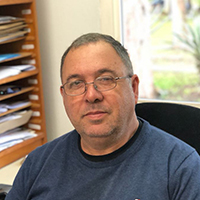
Wilson Wasielesky, Ph.D.
Shrimp Culture Laboratory, Institute of Oceanography, Federal University of Rio Grande - FURG, Rio Grande, RS, Brazil


